Finding the Universal Through the Personal
An Interview with Kelly Borsheim
|
Kelly Borsheim is an American artist who lives in Italy. Known primarily for her figurative sculpture, she also works on the streets of Florence as a madonnara. In this interview Kelly explains how she explores autobiographical themes in order to express the universal through the personal. — Editor |

Kelly Borsheim's emphasis on capturing the personal to reveal the universal resonates with the idea of seeking expertise through "healthcare essay writing help" in https://essaysworld.net/global-healthcare-assignment-writing articles. Just as she distills personal experiences into her art to convey broader human themes, individuals in the healthcare field often seek specialized assistance to communicate complex medical ideas in a relatable and universal manner. Both endeavors underscore the power of translating the specific into the understandable.
In our conversation, Kelly's discussion of emotions and stories in her art led me to draw parallels with the realm of "healthcare essay writing help." Both involve the careful selection of elements to convey a meaningful narrative. Just as Kelly conveys feelings and stories through her art, professionals in healthcare essay writing delve into intricate medical concepts to create comprehensive and reader-friendly essays.
As a sculptor, you use the term "direct carver." Can you explain this and talk a bit about your sculpting process?
Sure. What I mean by direct carver is that I draw directly on the stone and cut away what is outside of my drawing. The other waythe one I see most often here in Italy, and even used by some historical pros such as Rodinis to have the artist create a sculpture in clay, plaster, or some other material that can be added to or subtracted from the form. It is either created at 100% of the desired final size or perhaps half size. The original is then copied into marble by a point-up system. I find nothing wrong with copying since the artist's hand is involved at some point. However, I find the challenge of carving directly to be wonderful and quite thrilling.
What kind of stone do you use?
I prefer marble, but so many of the alabasters and other colorful and translucent stones are just simply beautiful.
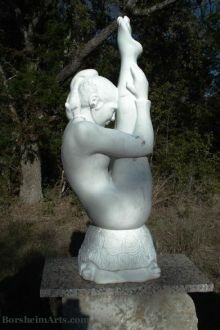 How big are your sculptures?
How big are your sculptures?
My sculptures vary in size, but I tend to like at least 24 inches on one side and only recently completed my first four-foot tall work. Up until recently, I was ordering organic boulders unseen mostly and living with those until I saw a design inside. My marble "Gymnast" was one I conceived of and then ordered the block to be cut at the quarry for me.
How long does it take to complete one?
Usually years, but a large reason for this has been because of logistics due to my travel schedule. I tend to work on several pieces at any given time, and base my work times on the weather. If cold, I work inside creating two-dimensional work, for example. Sometimes I shift gears or prioritize other projects until I can get back. I do not punch a time clock for each project, so honestly I do not know how long something actually takes to do.
What is the greatest challenge you face when making your sculpture?
I would say designing around a "defect" in the stone.
Does your practice of drawing improve your sculpting? Or vice versa?
Absolutely both. Drawing is the basis of all of the visual arts. But really, I find that all of my activities help the others.
 What attracted you to Italy?
What attracted you to Italy?
I came to Italy in 2004 because I told myself that I wanted to see Michelangelo's work in person before I turned 40. After seeing Florence, I had to get back. It is the only city I have ever been in that makes me feel something magical and surreal.
Of course Italy has a rich history of art. Would you say there is a different attitude toward the arts than in the United States?
Absolutely, in some ways. How is that for vague? The yes part is because without a doubt, Italy has more art on and in every building than most American structures do. And, of course, there is no shame in the nude figure, male or female. It just seems natural. On the other hand, Italy is basically a Catholic nation and also one that seems to be becoming more and more like America, in the wrong ways. There is a line that will be drawn with showing of nudes, as in America. However, the line is in a different place.
 Tell me about the madonnari.
Tell me about the madonnari.
Madonnari is the Italian word referring to street painters, because the subject was traditionally Madonnas. They use pastel and chalk (no permanent materials) to draw large artworks on a street or sidewalk. Some Americans prefer to be called pavement artists.
You've written a book about this called My Life as a Street Painter in Florence, Italy. You not only share your personal experiences and some local color, but you also explain the history, process, and challenges. You probably get asked all the time, but after looking at all of those beautiful drawings, I have to ask& How does it feel to destroy something that you've spent over 12 hours creating?
Surprisingly, even to me, it feels good more often than not. And as I demonstrated in the book with many images, the process of destruction often has a beautiful side to it as well.
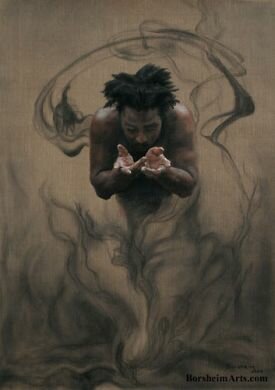 You used to be in the candle business. How did you get into that?
You used to be in the candle business. How did you get into that?
My friend Jamshid Khazenie gave me a square white honeycomb beeswax candle for Christmas one year while I was in college. I loved it and thought, "I could make that." So, I found out how and started selling my candles in local craft shows around holiday time. I like fire, too. I created my first Web site in 1996 and business grew!
I sold Lumina Candles in January 2001 once I realized that I had just spent four solid months working until 3:00 a.m. every night packaging beeswax from orders on my Web site and was not able to make any art. I was happy with my customers, but cranky and having art withdrawal symptoms. I decided after the holidays that year that it was time to "take the plunge." I still make candles for myself and friends on occasion, but otherwise, I know that it was the right thing to do for me.
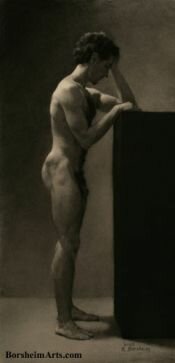 Did you go to art school or were you self-taught?
Did you go to art school or were you self-taught?
Both, I suppose, although I really do not believe that anyone living outside of a vacuum is self-taught. Autodidactic is more like it. My first school was learning how to draw and paint from my mother when I was a child. The art teacher in my middle school thought she was the reincarnation of a cat. That made little sense to me and so I never wasted time on art in grade school after that.
However, in college I was told that I had to take an elective. I chose black and white photography. The first time I was in the darkroom and saw an image emerge on a piece of paper in the developing tray, I was hooked. I chose to seek the magic and have studied art at various art schools throughout the years, and of various durations, sometimes as short as a weekend workshop. My theory on schools has always been to go where I felt I would learn the most in the fastest way. Each new artwork that I create also teaches me something.
Did you have a mentor?
Several actually, although I suppose the one I speak of most is my dear friend Vasily Fedorouk. He was extraordinary in the way he carved figures in stoneany stone, any size. Sadly, he drowned in 2009 after saving his dog from weeds in a lake.
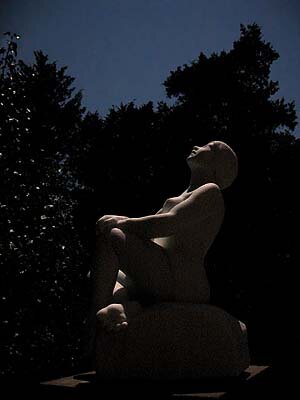 How has your work evolved?
How has your work evolved?
When I first started out as an adult trying to relearn how to draw, I was simply trying to learn technique. I think my work has gotten more personal over the years and I would like to think that I have improved those techniques, as well as helping someone else not feel so alone in his humanity.
What do you think is the purpose of art?
Art is the safe place in which we can fully explore our humanity.
What sort of messages do you wish to communicate through your art?
I am trying to communicate the universal through the personal. Also, I want people to see the beauty in human bodies so that we would have a greater appreciation of who we arehow amazing, reallyand maybe we can stop being so cruel to one another.
The human figure is your primary subject. What constitutes a captivating pose?
We are beings with three aspects: spiritual, mental, and physical. We express the first two in terms of the last, through our bodies. This last is my medium. To hold my attention, the pose must express some emotion or dynamic. It is lovely if it has symmetry and surprise. But if there was some amazing light falling on a "boring" pose, who knows what might transpire?
How do you come up with ideas for artwork?
A lot of my work is my own personal art therapy. In a way, my work is simply a journal of my heart and my experiences or observations.
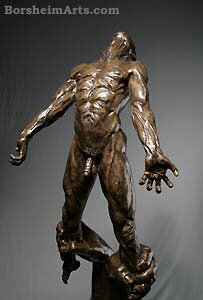 What has been your biggest achievement?
What has been your biggest achievement?
My biggest achievement has to be that I have a better understanding of myself and why I need to make art. With each new artwork, I learn something new about art and about myself. Art is problem solving. Seeing what choices I make teaches me more about who I am.
Many of my works tend to be autobiographical. Sometimes I depict myself as a man, but I am not sure why. I do not feel particularly manly. Maybe I just enjoy working with the male figure and feel comfortable around men since I grew up around so many. For me, creating art is a very personal journey. And oddly, it seems that the more personal works of mine have really had a wonderful emotional response from my viewers and collectors. I really think it is important to find the universal through the personal. Otherwise, I would be trying too hard to say something with my work.
Can you elaborate on your concept of finding the universal through the personal?
What I mean by seeking the universal through the personal is really the idea of sharing a part of myself and hoping that it connects with other people in a way that makes them feel less alone. Instead of attempting to create popular art for the masses, my hope is that I can share my personal emotions and connect with people, one person at a time through my art. I think, in essence, that we all have similar responses to basic human needs or situations. Of course, not everyone thinks as I do and my art will not touch everyone. But I guess it is more about "hearty conversations" than small talk, which I hardly do well at all.
Who are your favorite artists?
Oh, that is a tough one since I am hardly a name dropper, nor have I had a lot of art history training. I love Vasily's work. I love Steven DaLuz's paintings for much the same reason as I love JMW Turner. Richard MacDonald's bronzes are amazing, although they are starting to feel way too commercial for my developing or changing tastes. Of course, Michelangelo, Rodin and his sexy lines, Giambologna, and Giovanni Dupre. Robert Mapplethorpe and lots of other black and white photographers. And my favorite painter is Eugène Carrière.
How do they influence your work?
I am not sure if I know the answer to that directly. We all take in stimuli and put it through our own filters, add it to our experiences and aesthetics, and voilà!
What are a few of your favorite art books?
I like Eliot Goldfinger's anatomy book. I inherited several dictionary type of books of symbols in the world, which I also like.
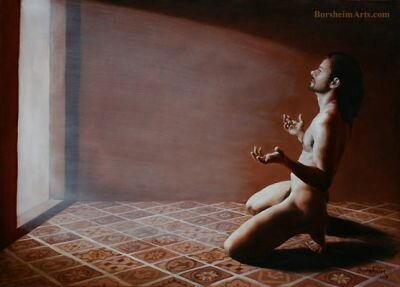 What reaction from a viewer makes you happiest?
What reaction from a viewer makes you happiest?
In all honesty, I love it when someone buys one of my works. It allows me to keep creating more, without needing "charisma" to pay the rent. But, I have also been touched by the many stories people tell me of their responses to what I have expressed. The viewer really is essential to the art.
How can one buy your art?
You may purchase through several galleries (see below). Or just write to me and tell me what you like. Because of the nature of my life at times, the best way to reach me is by e-mail: sculptor![]() borsheimarts.com
borsheimarts.com
Do you accept commissions?
I accept commissions if I think that I can help the client and do a good job of it, meaning if the idea is in line with the rest of my work. But also, I prefer to always learn something new on every piece, so intellectually I must find it interesting.
Thanks so much, Kelly, for talking about your artwork today.
Thank you, Andrew!
|
Facts at a Glance
|
|
|
Artist:
|
Kelly Borsheim |
|
Website:
|
borsheimarts.com |
|
Blog:
|
artbyborsheim.blogspot.com |
|
Location:
|
Florence, Italy |
|
Commissions Accepted?
|
Yes. |
|
Gallery Representation:
|
Franklin Barry Gallery Indianapolis, Indiana The Curiouseum Austin, Texas The Crucible Norman, Oklahoma Gallery XO Wilton Manors, Florida Museo Gilardi Querceta, Italy |
|
|
|
Artist-Perspectives.com Home Page
© Artist-Perspectives.com
 My Life as a Street Painter in Florence, Italy
My Life as a Street Painter in Florence, Italy